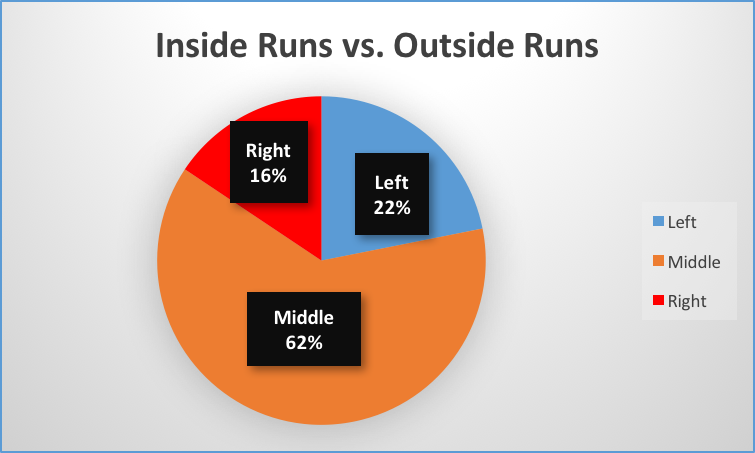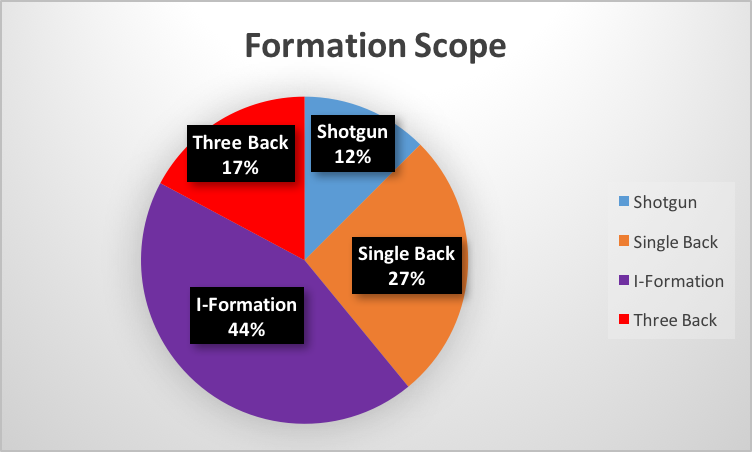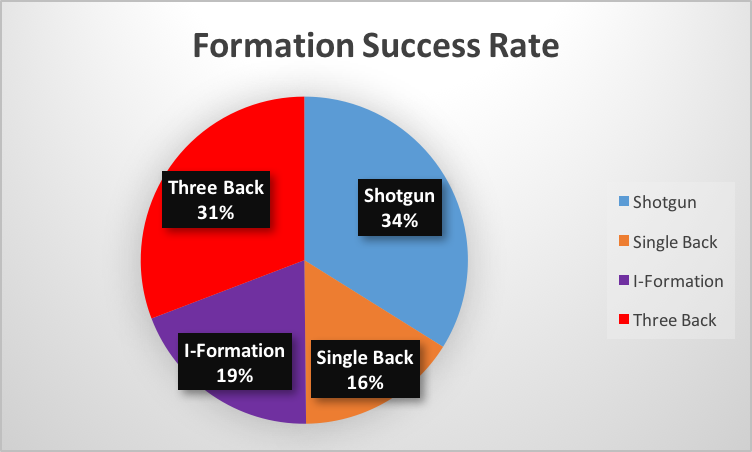Devy Profile: LJ Scott, RB Michigan State
Injuries, constant change in personnel, and yearly position battles to retain the job as the team’s starter can slowly ware on a player. It’s easy to see why player values for college prospects tend to fluctuate during a player’s collegiate career.
LJ Scott has experienced a recent rise in his stock due to a solid performance in the last half of the 2016 season with big games against both Ohio State and Michigan. With a slow start to his collegiate career, Scott manage to live up to the hype by finishing his sophomore season by eclipsing the 100-yard mark in four of his last six games, increasing his value in devy leagues.
As a Recruit
Scott went to school at Hubbard High School, located about an hour and a half northeast of Columbus, Ohio. He was a four-year starter in high school where he rushed for 2,819 yards and 38 touchdowns while averaging 9.6 yards per carry during his senior season.
247Sports had him ranked as the sixth-best back in the 2015 recruiting class and the second-best prospect from the state of Ohio behind Justin Hilliard, linebacker for Ohio State. He drew interest from multiple different collegiate programs like Alabama, Ohio State, Auburn, Pittsburgh, Tennessee, West Virginia and Kentucky before signing his letter of intent with the Michigan State Spartans.
Freshman Season
[am4show have=’g1;’ guest_error=’sub_message’ user_error=’sub_message’ ]
He played in 14 games in 2015 as a true freshman, leading the team in rushing with 699 yards and 11 touchdowns while making three receptions for 15 yards. His best game came during week five when he rushed for 146 yards and two touchdowns against Purdue. He also managed to score the game winning touchdown against Iowa in the Big Ten Championship Game.
Sophomore Season
Michigan State experienced a forgettable downward spiral in 2016 that generated a dismal 3-9 overall record with a 1-8 record in Big Ten play. The offense experienced a lot of growing pains. Tyler O’Connor attempted his first season as the team’s starting quarterback and the offensive line as a unit lacked a lot of experience.
Even with all the peril surrounding the offense, Scott managed to rush for 994 yards and six touchdowns while owning a 24.07 percent market share of Michigan State’s offensive production during his sophomore season. He finished the season with five games with over 100 yards rushing and his best game came against Ohio State when he rushed for 160 yards and one touchdown while catching two balls for 76 yards and one touchdown.
He caught fire during the second half of the season rushing for 658 yards in his last six games while averaging 5.93 yards per carry. Ohio State and Michigan are both known for their tough run defenses, and Scott managed to rush for a total of 299 yards while averaging 7.29 yards per carry against both of them.
Athleticism
Scott’s 6’1’’ 231-pound frame provides the inclination that he has the size to handle a full workload at the NFL level. He supposedly ran 4.42 40-yard dash in high school, but from watching him on film, it’s easy to tell that he doesn’t possess that type of speed. His timed speed won’t be available to us until the combine, but his film suggests that he doesn’t have the speed to burn by defensive backs. His size and power is his greatest asset, because he does a tremendous job at lowering his pad level to get the extra push for additional yardage.
Running Style
Scott is more often the hammer than the nail at the point of contact. He’s a very aggressive runner who strives to run over as many defenders as possible at the end of every run. His ability to run through defenders along with his power are the main attributes to his game.

The chart above is derived from statistics from games against Michigan, Ohio State and Furman, a three-game sample from the 2016 season.
Michigan State is very aware of his ability to grind out tough yards between the tackles, because they called for 62 percent of his run plays to go up the gut of the defense. Another thing to note – Scott is always running downhill and rarely bounces any of his runs to the outside of the defense.
Most of his runs that go outside of the tackled box are usually ordered-up by the offensive coordinator and are typically designed runs out of shotgun and two back sets (I-formation and broken-I formations).

The statistics in the chart above reflect how many times he lineup in the listed formations during his games against Michigan, Ohio State and Furman in 2016.
He received most of his carries out of I-formation or a broken-I. Scott would also get a lot of looks out of the single back formation. Michigan State’s “Three back formation” consisted of Scott, the fullback and a tight end lined up in the backfield. The Spartans utilized this formation to disguise which side they were going to run at.
Overall, Scott’s diverse usage will only help his transition to the NFL level, because he has experience in all phases of the game.

The statistics in the chart above display his success rate (plays of four yards or more) in the listed formations during his games against Michigan, Ohio State and Furman in 2016.
According to the graph above, Scott was most successful out of the shotgun. Keep in mind he only ran 12 per cent of his carries out of shotgun and the sheer nature of the formation generally causes the opposing defense to spread out their personnel, allowing more favorable looks for Scott.
Three-back sets were also very advantageous for him, because the extra blocker in the backfield masked the direction of the run. In three-back sets, the defense also had to account for play action and handoffs to the fullback, causing a lot of confusion for the opposing defenses. He was still very successful in I-formation, given that 44 per cent of his carries from this formation. His lack of success out of single back is mostly due to the ineffectiveness of the offensive line and the need for an extra blocker out of the backfield for Scott to be able to have a big enough crease to net positive yardage.
As a runner, he’s maturing at a rapid rate. He has developed the patience to wait for his offensive linemen to set up their blocks and has increased his ability to make pre-snap reads. He has a knack for anticipating the defenders next move, making it easy for him to cut away from defenders in the open field.
The major drawback to his game is his lack of speed and inability to get to the edge. He will sometimes get caught from behind by linebackers and nickel corners while trying to push runs to the outside of the defense. He’s not a threat to score from anywhere on the football field, because he doesn’t have the speed to blow by defensive backs for long touchdown runs.
His burst running through the hole is also questionable, because sometimes he appears to be a little sluggish when trying to get to the second level of the defense. Scott may need to drop some weight in the near future if he wants to improve upon his speed and quickness.
Passing Game
Even though he only has 13 receptions for 162 yards and one touchdown during the last two years of his career, Michigan State does try to get him involved in the passing game by splitting him out wide as a receiver and checking down to him in the flat whenever possible. His hands are good enough to catch dump offs and short passes out of the backfield.
His lack of involvement in the passing game is going to get a lot of attention when he declares for the draft, because the raw statistics is what a lot of analysts will focus on. When it comes to catching short passes, Scott has the intangibles to get the job done.
He’s also a willing blocker and is not afraid to mix it up with blitzing defensive ends and linebackers. On occasion, he will miss a block or two, but that’s typical with most college running backs. Overall, he’s rock solid when it comes to pass protection.
NFL Comparison
Jordan Howard’s aggressive running style and his ability to get downhill draws close comparisons to the way Scott plays the game. Both players are very similar when it comes to size, speed and quickness. The main difference between the two backs is Howard’s college production, rushing for 3,681 yards and 24 touchdowns during his collegiate career.
Summary
This season is a going to be very influential to how he will be valued next spring if he decides to declare for the draft. If he performs well this season and surpasses 1,000 yards rushing, then he will more than likely leave school for the NFL. If he remains healthy throughout the 2017 season, then he should finish the year as one of the top rushers in the Big Ten. Scott is a very talented running back and if he continues to develop then he could become a very successful player at the next level.
[/am4show]
- 2024 NFL Draft: What We Expect for Day 2 - April 26, 2024
- 2024 NFL Draft: What We Expect for Day 1 - April 25, 2024
- Dynasty Fantasy Football Rookie Profile: Luke McCaffrey, WR Rice - April 19, 2024


































































